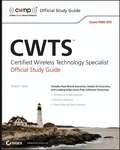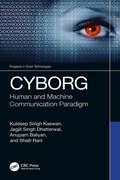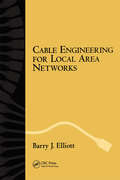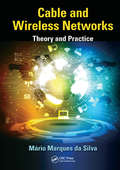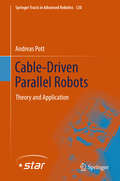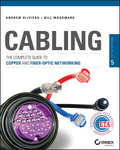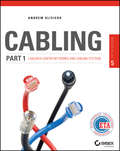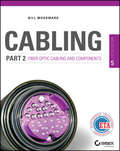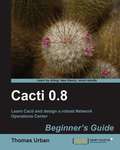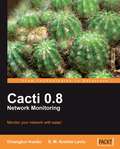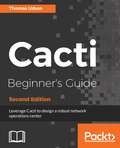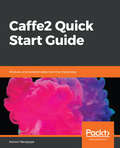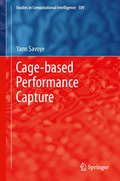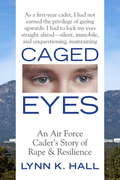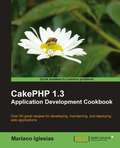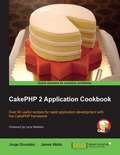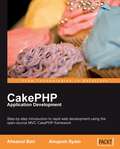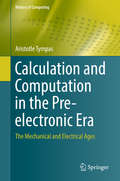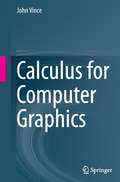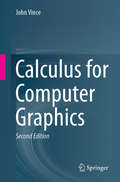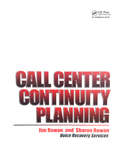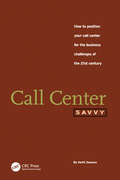- Table View
- List View
CWTS: Certified Wireless Technology Specialist Official Study Guide
by Robert J. BartzAbout the Book This Official Study Guide for the CWTS exam features complete coverage of the exam objectives, as well as hands-on exercises, Real World Scenarios, chapter review questions, a detailed glossary, objective map, and a pre-assessment test. The enhanced CD includes two bonus exams, 150 flashcards, Case Studies, and demo software. Exam coverage includes: Wi-Fi Technology, Standards, and Certifications Hardware and Software Radio Frequency (RF) Fundamentals Site Surveying and Installation Applications, Support, and Troubleshooting Security & Compliance About the CWTS Certification The Certified Wireless Technology Specialist (CWTS) is a vendor-neutral certification administered by CWNP. This brand new certification is the only entry-level vendor neutral wireless certification for IT Professionals, and was developed for IT support staff who work with wireless technologies. It is a springboard to the foundation-level Certified Wireless Network Administrator (CWNA), and more advanced Certified Wireless Security Professional (CWSP) and Certified Wireless Network Expert (CWNE) certifications. The exam is offered in over 100 countries through both Prometric and Pearson VUE testing centers. The cost of the exam is $125. Note: CD-ROM materials for eBook purchases can be downloaded from CWNP's website at www. cwnp. com/sybex
CYBORG: Human and Machine Communication Paradigm (Prospects in Smart Technologies)
by Shalli Rani Jagjit Singh Dhatterwal Kuldeep Singh Kaswan Anupam BaliyanThis book provides in-depth information about the technical, legal, and policy issues that are raised when humans and artificially intelligent machines are enhanced by technology. Cyborg: Human and Machine Communication Paradigm helps readers to understand cyborgs, bionic humans, and machines with increasing levels of intelligence by linking a chain of fascinating subjects together, such as the technology of cognitive, motor, and sensory prosthetics; biological and technological enhancements to humans; body hacking; and brain-computer interfaces. It also covers the existing role of the cyborg in real-world applications and offers a thorough introduction to cybernetic organisms, an exciting emerging field at the interface of the computer, engineering, mathematical, and physical sciences. Academicians, researchers, advanced-level students, and engineers that are interested in the advancements in artificial intelligence, brain-computer interfaces, and applications of human-computer in the real world will find this book very interesting.
Cable Engineering for Local Area Networks
by Barry J. ElliottA guide to the design, procurement, installation and testing procedures for local area networks (LANs) using copper and optical fibre cable technology. It describes the theory as well as practical issues involved in the complexities of today's office-based LANs. It also compares international, European, and US LAN and premises cabling standards.
Cable and Wireless Networks: Theory and Practice
by Mário Marques da SilvaCable and Wireless Networks: Theory and Practice presents a comprehensive approach to networking, cable and wireless communications, and networking security. It describes the most important state-of-the-art fundamentals and system details in the field, as well as many key aspects concerning the development and understanding of current and emergent services. In this book, the author gathers in a single volume current and emergent cable and wireless network services and technologies. Unlike other books, which cover each one of these topics independently without establishing their natural relationships, this book allows students to quickly learn and improve their mastering of the covered topics with a deeper understanding of their interconnection. It also collects in a single source the latest developments in the area, typically only within reach of an active researcher. Each chapter illustrates the theory of cable and wireless communications with relevant examples, hands-on exercises, and review questions suitable for readers with a BSc degree or an MSc degree in computer science or electrical engineering. This approach makes the book well suited for higher education students in courses such as networking, telecommunications, mobile communications, and network security. This is an excellent reference book for academic, institutional, and industrial professionals with technical responsibilities in planning, design and development of networks, telecommunications and security systems, and mobile communications, as well as for Cisco CCNA and CCNP exam preparation.
Cable-Driven Parallel Robots: Proceedings Of The Second International Conference On Cable-driven Parallel Robots (Mechanisms and Machine Science #12)
by Andreas PottCable-driven parallel robots are a new kind of lightweight manipulators with excellent scalability in terms of size, payload, and dynamics capacities. For the first time, a comprehensive compendium is presented of the field of cable-driven parallel robots. A thorough theory of cable robots is setup leading the reader from first principles to the latest results in research. The main topics covered in the book are classification, terminology, and fields of application for cable-driven parallel robots. The geometric foundation of the standard cable model is introduced followed by statics, force distribution, and stiffness. Inverse and forward kinematics are addressed by elaborating efficient algorithms. Furthermore, the workspace is introduced and different algorithms are detailed. The book contains the dynamic equations as well as simulation models with applicable parameters. Advanced cable models are described taking into account pulleys, elastic cables, and sagging cables. For practitioner, a descriptive design method is stated including methodology, parameter synthesis, construction design, component selection, and calibration. Rich examples are presented by means of simulation results from sample robots as well as experimental validation on reference demonstrators. The book contains a representative overview of reference demonstrator system. Tables with physical parameters for geometry, cable properties, and robot parameterizations support case studies and are valuable references for building custom cable robots. For scientist, the book provides the starting point to address new scientific challenges as open problems are named and a commented review of the literature on cable robot with more than 500 references are given.
Cabling
by Bill Woodward Andrew OlivieroDevelop the skills you need to design and build a reliable, cost-effective cabling infrastructureFully updated for the growing?demand of fiber optics for large-scale communications networks and telecommunication standards, this new edition is organized into two parts. Part I covers LAN Networks and Cabling Systems offers comprehensive coverage on current cabling methodologies and is updated to the latest industry standards. Part II addresses Fiber-Optic Cabling and Components probes deeper into fiber optics, and can be used to prepare for the Fiber Optics Installer (FOI) and/or Fiber Optics Technician (FOT) certifications, two of the Electronic Technician's Association's leading certifications.Explains why cutting corners is a bad ideaWalks you through the obstacles to high-speed data transferEncourages you to follow the golden rules of cablingThis new edition is the only book you need for current cabling methodologies and standards.
Cabling Part 1
by Andrew OlivieroWith the growing demand for fiber optics in large-scale communications networks, network professionals need complete, up-to-the-minute information. This book constitutes Part 1 of Cabling: The Complete Guide to Copper and Fiber-Optic Networking and focuses on LAN Networks and Cabling Systems, offering comprehensive coverage on current cabling methodologies and is updated to the latest industry standards. Contents include:1. Introduction to Data Cabling.2. Cabling Specifications and Standards.3. Choosing the Correct Cabling.4. Cable System and Infrastructure Constraints.5. Cabling System Components.6. Tools of the Trade.7. Copper Cable Media.8. Fiber-Optic Media.9. Wall Plates.10. Connectors.11. Transmission Equipment.12. Ubounded (Wireless) Media.13. Cabling-System Design and Installation.14. Cable-Connector Installation.15. Cable-System Testing and Troubleshooting.16. Creating a Request for Proposal.17. Cabling @ Work: Experience from the Field.
Cabling Part 2
by Bill WoodwardA special e-book edition for network admins and technicians dealing with fiber opticsCabling is crucial to network performance, and incorrect use of cables can result in outages and constant troubleshooting. Specific standards and processes must be employed when working with fiber optics. This convenient e-book comprises Part 2 of the popular and fully updated Cabling: The Complete Guide to Network Wiring, 5th Edition, with extensive coverage of fiber optics for large-scale communications networks and telecommunications standards. You will learn principles and practices essential to successfully installing and maintaining a fiber-optic network.Convenient e-book format is accessible on tablets and mobile devicesExamines the principles of fiber optic transmission, optical fiber characteristics and construction, and basic principles of lightIncludes coverage of fiber optic cables, light sources, detectors, and receivers; passive optical networks, components, and multiplexers; and system design considerationsExplains splicing, connectors, safety considerations, link/cable testing, troubleshooting, and restorationCovers the objectives for popular Data Cabling Installer Certification (DCIC), Certified Fiber Optics Installer (CFOI), and Fiber Optic Technician (FOT) examsCabling Part 2: Fiber-Optic Cabling and Components, 5th Edition has the information you need to master every aspect of setting up and managing a fiber-optic network.
Cacti 0.8 Beginner's Guide
by Thomas UrbanWritten for beginners to Cacti, this book contains step-by-step instructions and hands-on tutorials for network operators to learn how to implement and use the core Cacti functions. The book is designed in such a way that you can explore it chapter-by-chapter or skip any chapter without missing a beat.If you are a network operator and want to use Cacti for implementing performance measurement for trending, troubleshooting, and reporting purposes, then this book is for you. You only need to know the basics of network management and SNMP.
Cacti 0.8 Network Monitoring
by Dinangkur Kundu S. M. LavluWith loads of screenshots and illustrations and easy step-by-step instructions, this book is ideal for beginners in the network monitoring business. This book is for anyone who wants to manage a network using Cacti. You don't have to be a Linux Guru to use this book.
Cacti Beginner's Guide: Leverage Cacti to design a robust network operations center
by Thomas Urban Glyn AstillKey Features A complete Cacti book that focuses on the basics as well as the advanced concepts you need to know for implementing a Network Operations Center A step-by-step Beginner's Guide with detailed instructions on how to create and implement custom plugins Written by Thomas Urban – creator of the “Cereus” and “NMID” plugins for Cacti known as Phalek in the Cacti forum Book Description Cacti is a performance measurement tool that provides easy methods and functions for gathering and graphing system data. You can use Cacti to develop a robust event management system that can alert on just about anything you would like it to. But to do that, you need to gain a solid understanding of the basics of Cacti, its plugin architecture, and automation concepts. Cacti Beginner's Guide will introduce you to the wide variety of features of Cacti and will guide you on how to use them for maximum effectiveness. Advanced topics such as the plugin architecture and Cacti automation using the command-line interface will help you build a professional performance measurement system. Designed as a beginner's guide, the book starts off with the basics of installing and using Cacti, and also covers the advanced topics that will show you how to customize and extend the core Cacti functionalities. The book offers essential tutorials for creating advanced graphs and using plugins to create enterprise-class reports to show your customers and colleagues. From data templates to input methods and plugin installation to creating your own customized plugins, this book provides you with a rich selection of step-by-step instructions to reach your goals. It covers all you need to know to implement professional performance measurement techniques with Cacti and ways to fully customize Cacti to fit your needs. You will also learn how to migrate Cacti to new servers. Lastly you will also be introduced to the latest feature of building a scalable remote poller environment. By the end of the book, you will be able to implement and extend Cacti to monitor, display, and report the performance of your network exactly the way you want. What you will learn Setting up Cacti on Linux and Windows systems Extending the core functionality by using the plugin architecture Building your own custom plugins Creating your own custom data input method to retrieve data from your systems Using SNMP, SSH, and WMI to retrieve remote performance data Designing and create enterprise-class reports with the reporting plugins Implementing threshold-based alerting using the Thold plugin Automating common administrative tasks utilizing the command-line interface and the automate functionality Migrating Cacti to new servers Building a multi remote-poller environment
Caffe2 Quick Start Guide: Modular and scalable deep learning made easy
by Ashwin NanjappaBuild and train scalable neural network models on various platforms by leveraging the power of Caffe2Key FeaturesMigrate models trained with other deep learning frameworks on Caffe2Integrate Caffe2 with Android or iOS and implement deep learning models for mobile devicesLeverage the distributed capabilities of Caffe2 to build models that scale easilyBook DescriptionCaffe2 is a popular deep learning library used for fast and scalable training and inference of deep learning models on various platforms. This book introduces you to the Caffe2 framework and shows how you can leverage its power to build, train, and deploy efficient neural network models at scale.It will cover the topics of installing Caffe2, composing networks using its operators, training models, and deploying models to different architectures. It will also show how to import models from Caffe and from other frameworks using the ONNX interchange format. It covers the topic of deep learning accelerators such as CPU and GPU and shows how to deploy Caffe2 models for inference on accelerators using inference engines. Caffe2 is built for deployment to a diverse set of hardware, using containers on the cloud and resource constrained hardware such as Raspberry Pi, which will be demonstrated.By the end of this book, you will be able to not only compose and train popular neural network models with Caffe2, but also be able to deploy them on accelerators, to the cloud and on resource constrained platforms such as mobile and embedded hardware.What you will learnBuild and install Caffe2Compose neural networksTrain neural network on CPU or GPUImport a neural network from CaffeImport deep learning models from other frameworksDeploy models on CPU or GPU accelerators using inference enginesDeploy models at the edge and in the cloudWho this book is forData scientists and machine learning engineers who wish to create fast and scalable deep learning models in Caffe2 will find this book to be very useful. Some understanding of the basic machine learning concepts and prior exposure to programming languages like C++ and Python will be useful.
Cage-based Performance Capture (Studies in Computational Intelligence #509)
by Yann SavoyeNowadays, highly-detailed animations of live-actor performances are increasingly easier to acquire and 3D Video has reached considerable attentions in visual media production. In this book, we address the problem of extracting or acquiring and then reusing non-rigid parametrization for video-based animations. At first sight, a crucial challenge is to reproduce plausible boneless deformations while preserving global and local captured properties of dynamic surfaces with a limited number of controllable, flexible and reusable parameters. To solve this challenge, we directly rely on a skin-detached dimension reduction thanks to the well-known cage-based paradigm. First, we achieve Scalable Inverse Cage-based Modeling by transposing the inverse kinematics paradigm on surfaces. Thus, we introduce a cage inversion process with user-specified screen-space constraints. Secondly, we convert non-rigid animated surfaces into a sequence of optimal cage parameters via Cage-based Animation Conversion. Building upon this reskinning procedure, we also develop a well-formed Animation Cartoonization algorithm for multi-view data in term of cage-based surface exaggeration and video-based appearance stylization. Thirdly, motivated by the relaxation of prior knowledge on the data, we propose a promising unsupervised approach to perform Iterative Cage-based Geometric Registration. This novel registration scheme deals with reconstructed target point clouds obtained from multi-view video recording, in conjunction with a static and wrinkled template mesh. Above all, we demonstrate the strength of cage-based subspaces in order to reparametrize highly non-rigid dynamic surfaces, without the need of secondary deformations. To the best of our knowledge this book opens the field of Cage-based Performance Capture.
Caged Eyes: An Air Force Cadet's Story of Rape and Resilience
by Lynn K. HallAn insider’s account of misogyny and rape in the US military and her extraordinary path to recovery and activismDesperate to realize her childhood dream of being an astronaut, Lynn K. Hall was an enthusiastic young cadet. For Hall, the military offered an escape from her chaotic home—her erratic mother, absent biological father, and a man she called “dad” who sexually abused her. Resolute and committed to the Air Force Academy, Hall survived the ordeals of a first-year cadet: intense hazing from upperclassmen, grueling physical training, and demanding coursework. But she’s dismissed from the Academy when, after being raped by an upperclassman and contracting herpes, she is diagnosed with meningitis and left with chronic and debilitating pain.Betrayed by the Academy and overcome with shame, Hall candidly recounts her loss of self, the dissociation from her body and the forfeiture of her individuality as a result of the military’s demands and her perpetrator’s abuse. Forced to leave the military and return to the civilian world, Hall turns to extreme sports to cope with and overcome PTSD and chronic pain. She, in turn, reclaims herself on the mountain trails of the Colorado Rockies.An intimate account of grappling with shame and a misogynistic culture that condones rape and blames victims, Caged Eyes is also a transformative story of how it’s possible to help yourself and others in the aftermath of a profound injustice.
CakePHP 1.3 Application Development Cookbook
by Mariano IglesiasWritten in cookbook style, this book offers learning and techniques through recipes. It contains step-by-step instructions for CakePHP developers to create unique web applications. The book is designed in such a way that you can refer to things chapter by chapter, and read them in no particular order.If you are a CakePHP developer who wants to discover quick and easy ways to improve web applications, and to leverage all aspects of the framework, this book is for you. This book assumes that you already have knowledge of CakePHP, and general PHP development skills.
CakePHP 2 Application Cookbook
by James Watts Jorge GonzalezIf you are a CakePHP developer looking to ease the burden of development, then this book is for you. As a headfirst dive into the framework, this collection of recipes will help you get the most out of CakePHP, and get your applications baked in no time. Even if you're not familiar with the framework, we'll take you from basic CRUD building to useful solutions that will aid in getting the job done quickly and efficiently.
CakePHP Application Development
by Anupom Syam Ahsanul BariThis book starts by installing Cake and building our first application, then looking at each main component of a CakePHP application in detail. We then learn how to build Web 2.0 style applications quickly using a case study application. The book is packed with example code and demo applications, so that you can see techniques in action. If you already know PHP and want to develop cutting-edge Web 2.0 applications, or see how to write code in a faster, more productive way, then this book is ideal for you.
Calculation and Computation in the Pre-electronic Era: The Mechanical and Electrical Ages (History of Computing)
by Aristotle TympasThis text offers an introduction to the history of computing during the first (steam) and the second (electricity) industrial revolution.
Calculus for Computer Graphics
by John VinceStudents studying computer animation and computer games have to be familiar with geometry, matrices, vectors, rotation transforms, quaternions, curves and surfaces, and as computer graphics software becomes increasingly sophisticated, calculus is also being used to resolve its associated problems. The author draws upon his experience in teaching mathematics to undergraduates to make calculus appear no more challenging than any other branch of mathematics. He introduces the subject by examining how functions depend upon their independent variables, and then derives the appropriate mathematical underpinning and definitions. This gives rise to a function's derivative and its antiderivative, or integral. Using the idea of limits, the reader is introduced to derivatives and integrals of many common functions. Other chapters address higher-order derivatives, partial derivatives, Jacobians, vector-based functions, single, double and triple integrals, with numerous worked examples, and over a hundred illustrations. Calculus for Computer Graphics complements the author's other books on mathematics for computer graphics, and assumes that the reader is familiar with everyday algebra, trigonometry, vectors and determinants. After studying this book, the reader should understand calculus and its application within the world of computer games and animation.
Calculus for Computer Graphics
by John VinceStudents studying different branches of computer graphics have to be familiar with geometry, matrices, vectors, rotation transforms, quaternions, curves and surfaces and as computer graphics software becomes increasingly sophisticated, calculus is also being used to resolve its associated problems. <P><P> In this 2nd edition, the author extends the scope of the original book to include applications of calculus in the areas of arc-length parameterisation of curves, geometric continuity, tangent and normal vectors, and curvature. The author draws upon his experience in teaching mathematics to undergraduates to make calculus appear no more challenging than any other branch of mathematics. He introduces the subject by examining how functions depend upon their independent variables, and then derives the appropriate mathematical underpinning and definitions. This gives rise to a function’s derivative and its antiderivative, or integral. Using the idea of limits, the reader is introduced to derivatives and integrals of many common functions. Other chapters address higher-order derivatives, partial derivatives, Jacobians, vector-based functions, single, double and triple integrals, with numerous worked examples, and over a hundred and seventy colour illustrations. <P><P> This book complements the author’s other books on mathematics for computer graphics, and assumes that the reader is familiar with everyday algebra, trigonometry, vectors and determinants. After studying this book, the reader should understand calculus and its application within the world of computer graphics, games and animation.
Call Center Continuity Planning
by Jim RowanA disruption in your call center operation can conceivably cost you hundreds of thousands of dollars. And multiple disruptions can cost in the millions. Call Center Continuity Planning shows you how to plan for - and avoid - service interruptions through disasters large and small. This book will show you how to deal with everything from power outag
Call Center Savvy: How to Position Your Call Center for the Business Challenges of the 21st Century
by Keith DawsonIt's not just the technology, the people, or the customers. It's all three, and more: call centers are not just places where calls arrive. They are a strategic business asset, the core of your business's customer relationship strategy. Call Center Savvy is an exploration of how the call center works, and how it fits into the big picture. What the f
Call Me Maybe: Could it be love at first talk?
by Cara Bastone'Cara Bastone is one of the most talented writers in the romance genre today. With her signature blend of heart, humor, and honesty, Cara's books remind you that the best stories begin and end with hope' Lyssa Kay AdamsThe audio bestseller, available for the first time in ebook! True love is on the line in Cara Bastone's charming, laugh-out-loud rom-com, perfect for fans of Netflix's Love is Blind, Jo Watson, Lauren Layne and Hannah Orenstein!Paint your toes. Pick up the wrong coffee and bagel order. Drive from Brooklyn to Jersey in traffic so slow you want to tear your hair out. It's amazing all the useless things I can accomplish while on hold for three hours with customer service. Three hours when I should be getting the Date-in-a-Box website ready to launch at the big business expo in a few days. Except my shiny new website is glitching, and my inner rage-monster is ready to scorch some earth...when he finally picks up. Not the robot voice I expected but a real live human named Cal. He's surprisingly helpful and really knows his stuff, even if he's a little awkward...in an adorable way.And suddenly I'm flirting with him? And I think he's flirting back. And suddenly it's been hours, and we're still on the phone talking and ordering each other takeout while he troubleshoots my website.And suddenly we're exchanging numbers and sending texts and DMs every day, leaving voice mails (who even does that anymore?!). And suddenly I'm wondering if it's possible for two people to fall in love at first talk.Because I'm falling...hard.Readers are loving Call Me Maybe!'An adorable and thoroughly enjoyable read...I didn't want it to end''This is a short, sweet romance that I really enjoyed. Both Cal and Vera were great characters and I loved how this book starts with their conversation which was so much fun to read!...I was rooting for them so much''I love the concept of this book ...I felt it captured it perfectly in ebook form. I've never read anything like it and for that I loved it!''A short fun read. I loved both of the main characters...Looking forward to reading more from this author'
Call Me Maybe: Could it be love at first talk? (Love Lines)
by Cara Bastone'Cara Bastone is one of the most talented writers in the romance genre today. With her signature blend of heart, humor, and honesty, Cara's books remind you that the best stories begin and end with hope' Lyssa Kay AdamsThe audio bestseller, available for the first time in ebook! True love is on the line in Cara Bastone's charming, laugh-out-loud rom-com, perfect for fans of Netflix's Love is Blind, Jo Watson, Lauren Layne and Hannah Orenstein!'The thing I love most about Cara Bastone's books is her ability to find the romance in ordinary lives, the swoon in simple places...just normal folks falling in love. I ADORE it' 5* reader review Paint your toes. Pick up the wrong coffee and bagel order. Drive from Brooklyn to Jersey in traffic so slow you want to tear your hair out. It's amazing all the useless things I can accomplish while on hold for three hours with customer service. Three hours when I should be getting the Date-in-a-Box website ready to launch at the big business expo in a few days. Except my shiny new website is glitching, and my inner rage-monster is ready to scorch some earth...when he finally picks up. Not the robot voice I expected but a real live human named Cal. He's surprisingly helpful and really knows his stuff, even if he's a little awkward...in an adorable way.And suddenly I'm flirting with him? And I think he's flirting back. And suddenly it's been hours, and we're still on the phone talking and ordering each other takeout while he troubleshoots my website.And suddenly we're exchanging numbers and sending texts and DMs every day, leaving voice mails (who even does that anymore?!). And suddenly I'm wondering if it's possible for two people to fall in love at first talk.Because I'm falling...hard.Readers are loving Call Me Maybe!'An adorable and thoroughly enjoyable read...I didn't want it to end''This is a short, sweet romance that I really enjoyed. Both Cal and Vera were great characters and I loved how this book starts with their conversation which was so much fun to read!...I was rooting for them so much''I love the concept of this book ...I felt it captured it perfectly in ebook form. I've never read anything like it and for that I loved it!''A short fun read. I loved both of the main characters...Looking forward to reading more from this author'
Call of the Last Survivor: An Unofficial Fortnite Novel
by Ken A MooreWill Mikaleh and her friends unravel the mystery of the ruby key and discover who—or what—is the Lone Survivor? Of all the squads in what remains of the known world—that is, after the onset of “The Storm” and the mysterious zombie hordes that came with it—no squad has a reputation like Squad #43! Helmed by the valiant Mikaleh (a mighty Soldier) and her sidekick Janet (a stalwart and even-tempered Constructor), they’re known across the multiverse of servers as the deadliest dispatchers of Mist Monsters and Husks in all the land. Their reputation for finding and freeing survivors is unmatched, and they’re second-to-none when it comes to discovering clever tricks and secrets. Rounded out by Sam (an Outlander) and Sammy (a Ninja)—a quirky pair, who fight like brothers but always reconcile like best friends—Squad #43 seems on an unstoppable trajectory to combat The Storm and restore the world, bit by bit, to something like its former self. Yet Mikaleh can hardly believe her eyes when she returns to base camp one morning—after a long evening of satisfying zombie-killing—to find that the Husks appear to have. . . reached out to them! A mysterious message, seeming to be from the very monsters themselves, urges Squad #43 to attend a secret rendezvous in Canny Valley where more will be revealed. Never one to turn down a mystery, Mikaleh soon finds her squad plunged into a strange intrigue beyond her wildest dreams
